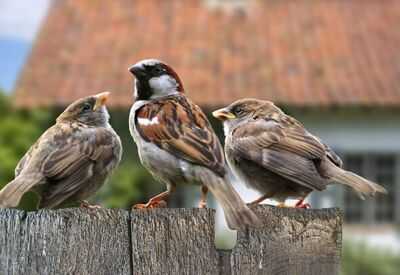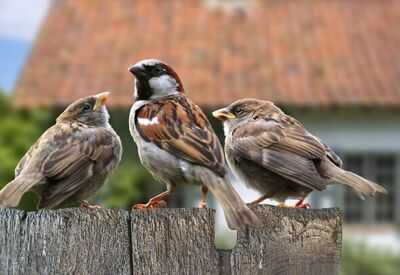
November is the month to roll out the red carpet for our feathered friends. Short days and long nights make food and shelter scarce, so small steps now make a big difference.
Smart feeding
Top up with a quality seed mix, sunflower hearts, and suet pellets. Add plain, unsalted peanuts into a wire feeder. Position apples on a bird table for thrushes and blackbirds, and a few live or dried mealworms for robins and wrens. Avoid any salty, sugary, or mouldy scraps. If you use fat balls, take them out of the mesh bags so feet and beaks are unlikely to snag.
Clean feeders and tables weekly with hot water, then dry before refilling to help reduce the risk of disease. Learn all about this and more in the latest episode of Step by Step gardening at my YouTube channel, @daviddomoney.
Consistent water
Fresh water matters just as much as food. Place a shallow dish or bird bath where cats won't be able to ambush. In frost, refresh with warm (not hot) water and float a small ball to slow freezing. Rinse away any algae before refilling.
Safe shelter
Give birds places to roost out of the wind. Thick hedges of holly, yew, pyracantha or privet are ideal. You can also hang roosting pouches in sheltered spots. Fix nest boxes now so they can be used for winter roosts and are ready for spring. Face boxes between north and east to avoid strong sun and driving rain. Mount 1-3m high, out of easy reach of predators, and away from busy feeders. Add a metal hole plate if squirrels are a problem.
Nest boxes
Different hole sizes suit different species. About 25mm helps blue tits and coal tits. Alternatively, around 28 mm suits great tits and tree sparrows. Approximately 32mm will welcome house sparrows and nuthatches. An open-fronted box set in a cover can attract robins and wrens. Clear old nesting materials with boiling water, then allow them to completely dry before rehanging.
Plant a natural larder
Berries and seedheads carry birds through lean weeks. Keep pyracantha for shelter and food near a boundary. Holly offers winter berries and dense cover, but remember only female plants bear berries with a male nearby, unless you have a self-fertile variety. Leave teasel, rudbeckia, and sunflower seedheads standing for finches. Guelder rose, hawthorn, cotoneaster, crab apple and ivy provides late food and structure. Just make sure not to strip everything at once. Lightly tidy paths and keep the banquet in place.
Simple weekly checklist
Top up feeders, supply fresh water, clean a feeding station and check boxes, ties, and fixings are secure. Step back and enjoy the visitors. With steady care in November, your garden becomes a safe stopover all winter long.
Top 5 gardening jobs
1 With roots dormant, climbers establish fast, so plant while the soil is workable. Good November choices include climbing roses, honeysuckle, winter jasmine, wisteria, and Virginia creeper. Soak the roots for an hour, plant 30-45cm from a wall and angle towards supports. Enrich the hole, backfill, water well, mulch, and tie in.
2 Brassicas prefer nearly neutral soil, so test pH where next year's cabbages and sprouts will grow. Use a simple kit, sampling a few spots at root depth. If readings are below about 6.5, note to add garden lime on a dry day, following the packet rates. Work it in lightly and retest later.
3 Tidy any plant pots now. Tip out old compost, shake off roots, and scrub in warm, mild disinfectant. Rinse and dry fully, binning cracked pots, and keeping terracotta shards as crocks. Stack by size, storing terracotta on wooden slats under cover, and raise outdoor containers on feet.
4 Sweet peas sown now make sturdy spring plants. Fill root trainers or deep pots with peat-free compost, sow two seeds per module at 2cm, and keep them cool, bright, and just moist. Pinch tips at 10cm to encourage bushy growth. Ventilate greenhouses on mild days to keep seedlings short and strong.
5Winter moth females crawl up trunks at night, so fit or refresh grease bands on fruit trees this month. Wrap the sticky band tightly around the trunk at about knee height and around supporting stakes, too. Press into bark crevices and check monthly. Replace if dusty or dry to keep protection effective into spring.
FOCUS ON Hardy chrysanthemums
At the start of November, hardy chrysanthemums (such as Chrysanthemum rubellum and other border-hardy garden hybrids) keep borders glowing. By contrast, bedding chrysanthemums (such as C x morifolium) are less reliably hardy outdoors. You can still plant if the soil is workable. Choose sun or light shade with free drainage. On heavy ground, mix in garden compost with grit. Water well after planting, then mulch. For borders, pick hardy, come-again varieties. Favourites include 'Clara Curtis', 'Sheffield Pink', warm apricot 'Mary Stoker', and the neat lilac pompoms of 'Mei-Kyo'. Plant in drifted clumps or repeat among grasses and autumn seedheads.
Single and semi-double forms can offer late pollen on mild days. Hold off major pruning. Tidy only dead, damaged or crossing shoots.
Do the main cut-down in late winter. For more plants, take basal cuttings in spring or divide congested clumps. Keep new plantings watered in dry spells. Clear leaves from crowns to reduce the risk of rot. Hardy chrysanthemums can be hit by mould in wet weather. Space for airflow and remove any faded foliage.
Fun fact: The name means "golden flower" in Greek, nodding to early yellow forms, though mums now bloom in many colours.
Did you know?
In British folklore, holly left in hedgerows was believed to block witches from "flying" or running along the hedge tops. It is a charming tradition explaining why boundary hollies were often spared during trimming.
All true tea comes from one plant, Camellia sinensis. White, green, oolong, and black teas are created by different processing methods after harvest, which change oxidation, flavour, and colour while the plant source remains the same. Learn how to grow a Camellia plant at my YouTube channel, @daviddomoney.
Many apple trees need a pollination partner flowering at the same time to crop well. Triploid varieties produce poor pollen, so cannot pollinate others reliably. Plant two compatible, non-triploid partners nearby to ensure consistent fruiting.
Chinese and Japanese wisterias twist in opposite directions. Chinese wisteria goes anti-clockwise, Japanese goes clockwise. Check the vine as it wraps the support and note the direction.
You may also like

What does 3I/ATLAS stand for? Where is it from? Everything you need to know to geek out about our interstellar guest

Lawyers can't be summoned by investigating officers unless approved by SP: SC

'Dead' Woman Wakes Up, Stuns Police Guarding Her 'Body' In Odisha's Boudh

"Not sure if it is feasible in today's legal environment...": Karti Chidambaram on Kharge's demand for ban on RSS

Assam CM Sarma performs bhumi pujan for 3 projects encompassing health and hospitality at Sarusajai with investment of Rs 800 crore







